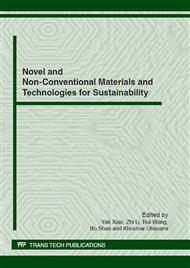p.331
p.338
p.342
p.352
p.357
p.363
p.367
p.371
p.376
Use of Vibrating Wire Strain Gauges to Monitor Corrosion-Induced Deterioration of Concrete
Abstract:
Steel reinforcement corrosion is always one of the most significant incentives of concrete structure deterioration, especially under severe chloride erosion environment. In order to describe the whole process of concrete deterioration induced by reinforcement corrosion, the mechanism of rust expansion and crack propagation in concrete was analyzed from the perspective of elastoplastic mechanics and fracture mechanics firstly, and experimental study was carried out to use vibrating wire strain gauges for monitoring corrosion-induced concrete deterioration process. The mechanism analysis of corrosion-induced concrete deterioration indicates that the degradation process of cover concrete can be divided into aggressive medium transmission process, free corrosive expansion process, corrosive expansion stress development process, corrosive expansion crack generation and propagation process, and vibrating wire strain gauges can be used to monitor corrosion-induced cover concrete stress development, crack initiation and propagation process along with the procedure of reinforcement corrosion. The test curve seems to be generally consistent with that of the theoretic analysis, and the signals captured by vibrating wire strain gauges can successfully reflect the durability degradation process of reinforced concrete structure under severe erosion environment.
Info:
Periodical:
Pages:
357-362
Citation:
Online since:
June 2012
Authors:
Keywords:
Price:
Сopyright:
© 2012 Trans Tech Publications Ltd. All Rights Reserved
Share:
Citation:


